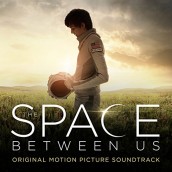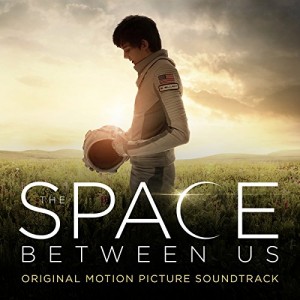
THE SPACE BETWEEN US soundtrack | ©2017 Sony Masterworks
From adolescents escaping a steampunk apocalypse shelter to kids taking on the Olympian gods to a college-age genius going back in time to solve daddy issues, Andrew Lockington is a composer with a fantastical, fresh sense of musical exploration and excitement. Beginning his own musical voyage in Canada alongside Oscar-winning composer Mychael Danna, Lockington had his mentor’s experimental, and often beautifully progressive stardust rub off on him as he progressed from assistant to orchestrator and conductor on such scores as FELICIA’S JOURNEY, GREEN DRAGON and MONSOON WEDDING, finally making his own solo break on indies like TOUCH OF PINK, SAINT RALPH and HOW SHE MOVE. But it was through his epically exciting work on Brad Peyton’s 3-D take of JOURNEY TO THE CENTER OF THE EARTH that Lockington truly thrust himself onto the Hollywood radar. His increasingly notable progress through such genre films as CITY OF EMBER, JOURNEY 2: THE MYSTERIOUS ISLAND, PERCY JACKSON: SEA OF MONSTERS and SAN ANDREAS showed Lockington’s talent for flexing an exuberantly thematic symphonic muscle – if not exactly the opportunity to combine his multiplex genre chops with romantic character drama, or the ethereal sound that inspired him.
That now changes in a big, beautiful way as Lockington’s talent for spectacle and emotion gets the chance to fully mesh for THE SPACE BETWEEN US. A sort of reverse MARTIAN, SPACE finds a literal starman (or boy as it were) in Gardner Elliot (Asa Butterfield), The result of an astronaut’s fatally unexpected pregnancy, Gardner has spent his entire life on the red planet, yearning to visit his roots, and find his father on an Earth he’s only dreamt of. The teen makes his great escape, not realizing that his interstellar upbringing will make his visit physically lethal. But perhaps the price will be worth it as Gardner finds adventure, and attraction with Tulsa (Britt Robertson), a girl who helps him go on the run from the well-meaning authorities. It’s an adventure that Lockington captures with a soaring, star-crossed feeling very much in tune with such alt. sci-fi scores as WALL-E, THE MARTIAN and PASSENGERS– a stylistic universe where strings and samples thematically forge into a surreal, captivatingly lush sound that’s not of this earth in the coolest ways. Percussion and oddball electronic samples convey a rocket ship future, while majestic strings play the natural, awe-struck wonder of an alien who just happens to be human, conveying the enchant of his first encounters with flying, animals and a girl’s touch – all while the ticking clock of his body’s out-of-place biology places his future in jeopardy. Lockington’s SPACE is a captivating, gorgeously poignant world to explore to both touching and exciting effect, a score that conveys youth appeal as a sense of wonder.
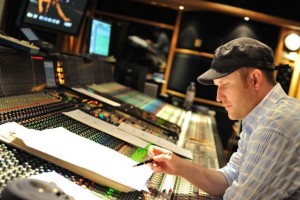
THE SPACE BETWEEN US composer Andrew Lockington | ©2017 Andrew Lockington
ASSIGNMENTX: Why do you think you have a particular affinity for scores that feature young characters exploring the unknown like JOURNEY 2: THE MYSTERIOUS ISLAND, CITY OF EMBER and PERCY JACKSON: SEA OF MONSTERS? And do you think that made you an ideal composer for THE SPACE BETWEEN US?
LOCKINGTON: What drew me to THE SPACE BETWEEN US were two things. One, I’ve been a huge fan of the director, Peter Chelsom, for many years. I remember seeing one of his films in the theater and saying to my wife afterwards that I’d love to work with that director someday. He has a way of putting his audience inside the consciousness of his characters. Somehow he manages to do it without the audience recognizing his methods and somehow he’s completely consistent with it on every project. I love the opportunity that gives the composer – not needing to pry that door open, but to already have it opened for you.
The second thing that drew me to the film was the script. Jason Markey, EVP of Music at STX, challenged me to come up with a way to tell an epic story using more intimate instrumentation in places. We sat in his office and I played him some sketches from my library of music ideas. He fell in love with the instrumentation of a song I wrote and that survived as an element for one of the themes in the film.
I loved that the film was telling a very intimate story within an epic landscape, and I immediately related to the characters despite the sci-fi nature of the story. It was a story everyone could relate to – finding the place you belong in this world. Gardner’s circumstances may take that statement far more literally, since he’s literally born on Mars, but his journey is one the audience will relate to, and helping the audience find their way inside the characters of a film is an important part of scoring a story.
AX: How do you think your score fits into the sound of character-driven sci-fi scores like WALL-E, THE MARTIAN and PASSENGERS, especially given that you were dealing with teenage characters?
LOCKINGTON: I didn’t set out to fit in with a “sound” per se, but more to properly reflect the relationships between the characters in this film. Not to say that the sci-fi element didn’t have any influence on the score, but I wanted to follow the main character’s journey as he looks to earth with fresh eyes (and ears). Everything is new to him, and everything is amazing. So I wanted the score to take that idea and run with it. That inspired me to look to more than just traditional music instruments and instead to find other ways of creating music.
I set out to find music in things we regularly overlook. Old ice cream bowls from a flea market in Paris, old trumpet mutes repurposed into a percussion instrument, salvaged rusted metal from old buildings, an old school bell, etc. I walked around with my cello bow, bowing everything and anything. I also armed myself with piano hammers (salvaged from the “San Andreas” piano I’d destroyed) and would strike random things with them. I discovered musical sounds in things I’d never imagined using in a score. Peter loved these ideas and these sounds, and then challenged me to use them in such a way that they wouldn’t sound discarded, and instead sound like they belonged with the orchestral elements they would be merged with.

THE SPACE BETWEEN US | ©2017 STX Entertainment
AX: On that note, how “sci-fi” did you want to make the score?
LOCKINGTON: Well the great thing about this exercise was that it put me in a place I wasn’t comfortable with musically. That’s a good thing for a composer. This process involved getting lost in the wilderness and using the elements around you to get back to a place you recognize. It was fantastic, and a lot of the sci-fi qualities people hear in the score weren’t set out to sound that way, but instead came from this approach. It not only worked well to guide my writing in this score, it’s most definitely affected how I will approach scoring other projects going forward.
In terms of ‘space’ and sci-fi, the only element we ever really discussed in that regard was reverb. When you’re working with music and artificial reverbs, you have the ability to isolate the reverberation of a sound and separate it from the dry source material. It’s not something you can do in nature, but it’s something musicians and engineers are very family with – removing the direct signal and hearing only the reverb. Peter and I started playing around with the idea of introducing a theme or a sound in reverb only, removing the source sound altogether. That idea influenced the “Launch Cue” where we not only used this approach, but also took it even further by using other waveforms in place of the traditional reverb impulses. Now, rather than the reverb just decaying, it follows another sound wave enveloping pattern. The end result was an orchestral element that could sound as natural, or as otherworldly as we wanted at any given time. That ability to choose became an important thematic element in the score.
AX: What do you think creates a musical sense of wonder, especially when it comes to strings and bell percussion?
LOCKINGTON: Music is a combination of so many elements – musical structure, simplicity, complexity, melody, amplitude, and chord progression. For this project, I was most focused on reflecting the innocence of Gardner, and his lack of social defensiveness. I loved that aspect of Asa’s character and of the story. As we look back on our lives, we all have memories where the fear of social judgment prevented us from doing something we wish we’d done or something we wish we’d said. Gardner doesn’t have that. He says what he thinks and does what he wants. It’s not that he doesn’t care what others think, he just hasn’t developed the defense mechanisms the rest of us have. His innocence is ridiculed by others in the story but we come to recognize his handicap as a gift. He’s immune to the paralysis the rest of us get from fear. His only fear is that he’ll die before experiencing what it’s like to be human. This helped me greatly. It gave the score license to do the same for his character and not adhere to the usual emotional filters required to score the other characters. The emotion of the score could follow Gardner and see the world through his eyes. I loved writing with his perspective.
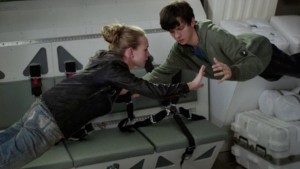
THE SPACE BETWEEN US | ©2017 STX Entertainment
AX: SPACE director Peter Chelsom has had a truly unique career with such movies as FUNNY BONES, THE MIGHTY and HANNA MONTANA: THE MOVIE. Given that this was his first movie in the genre, and with this kind of scope, how do you think you helped him meet the challenge?
LOCKINGTON: I love doing a film genre I’ve never done before so I can only imagine directors feel the same way. The hardest projects to do are the ones where they’ve temped your score and fallen in love with it. Those are the projects you need to figure out how to do something brand new for a genre you’ve successfully done before. Creative people don’t like doing the same thing multiple times, and Peter is no exception to that. I think that’s what made this film so perfect for him. I also think it gave him permission to explore humor in a different way than he has before. I love the humor in this film because there are no punch lines, and there’s no ridicule. Instead Peter helps us find the humor behind common slang and social rituals that, when you look at them from an outside perspective, are really quite ridiculous. He presents this in a very clever way such that you never feel sorry or judge Gardner for not understanding these moments, instead you laugh at yourself. You find humor in the understanding that something you’ve always said actually makes no sense. I hope the music was able to help him achieve that as well in some way.
AX: Tell us about your main themes for SPACE?
LOCKINGTON: The main theme, and most difficult theme in the film, was Gardner’s. When we meet him for the first time he’s just arrived – this beautiful baby in his mother’s arms – a moment in real life that emotionally only has one color, one element – it’s as pure an emotion as you can get. That really got me, because every other life moment is much more complex. When a loved one passes away, it’s not just sadness, it’s more complicated that that. But the birth of a baby, in that moment, is just pure love. So coming up with something for that moment alone would not have been complicated. But while that theme needed to represent Gardner’s birth, it had to do so much more. It needed to score his mother’s death. It needed to score his longing for finding his father. It needed to exist within completely contrasting emotions and much more complex situations as he journeyed through the story.
The theme I wrote doesn’t just represent Gardner, it represents hope, it represents tragedy, it represents humanity at it’s best and it’s worst. It was a huge challenge. My father is a very gifted painter, and talks often about the importance of mixing colors. The same paint color can project different qualities depending on the context in which you see it. Those complex shades of color need to be there, but be able to be hidden or emphasized by manipulating the context around it. This theme needed to do the same.
I had a similar challenge with the arc for Nathaniel (Gary Oldman). When we first start on this storyline it’s pure optimism. It’s a celebration of the technological achievement of sending a team of astronauts to live on another planet. Nathaniel is giving a speech to investors and introducing the ship and the astronauts to a crowd. It’s a euphoric moment the first time we experience it, but one that we revisit later in the film with the hindsight of the tragic circumstances that followed. This theme very much embodied his storyline and his character – the two were forever intertwined and interrelated, and like Gardner’s theme, it needed to be a chameleon and keep it’s shape while changing it’s color.
Probably my favorite theme in the film we called “Water”. I set out to write a melody that never resolved, that was always in conflict with it’s accompanying chord progression, yet could still feel beautiful. It needed to sound slightly off, yet sure of itself. So I wrote a melody I liked then took the melody and transposed it up a semi-tone while keeping the accompaniment in the same key. The result is a minor second clash between the first note of the theme and the chord. But by then moving the melody up an octave, the theme found a musical place where it almost belonged (a minor 9th sounds more pleasing than a minor 2nd). “Almost” was the operative word, because any resolution in the melody needed to be accompanied by a clash in the supporting chord, and vice-versa. Peter fell in love with it. The first time we hear it as a piece of Italian Opera that Carla Gugino’s character is working out to in the space station on Mars. Peter speaks Italian and wrote the lyrics to my melody. I found an amazing singer in Toronto, Maeve Palmer, and she did an incredible job performing the source piece. I love finding moments where you can introduce a theme in a way like this as it’s immediately engrained in the consciousness of the characters.
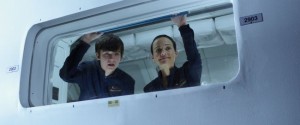
THE SPACE BETWEEN US | ©2017 STX Entertainment
AX: Beyond its “Martian” angle, a drawing point for the youth audience is its seemingly doomed romance. How did you want to play this aspect of the score, and to have the music make you root for its main couple?
LOCKINGTON: What I loved about the story is that the romantic connection happens while they’re on a mission to find Gardner’s father and experience the world before Gardner dies. As such, the music couldn’t be romantic in that way, and instead needed to, on the surface, score the romance of the journey. It’s a play on the famous John Lennon quote “Life is what happens when you’re making other plans”. Their romantic connection happens because she’s helping him experience everything in the world in a short few days. She’s very frustrated with the world and the hand she’s been dealt, so she gets a reset on how she sees the world as she joins him in seeing it through his eyes. As such, it was important that their connection motif only reveal its true meaning after we’d heard it many times before.
AX: Tell us about the race-against-time aspect of SPACE’s score to save Gardner from his own wanderlust?
LOCKINGTON: This is where a lot of the “found” and “junk” instruments became very useful. There is an accordion feel to the pace of the story. There’s definitely a ticking clock as they race to find Gardner before he dies, but that also serves to better show the moments in the story where time stands still and there’s a lack of pace and time. I had fallen in love with the inherent pitches of these instruments and knew I had to use them in their natural form as much as possible. I would play a lot of rhythmic patterns on them and record absolutely everything I improvised. Many of those initial ideas I was able to edit and cut together to become important motor elements in the score.
AX: Could you talk about achieving a balance between the orchestra and the music’s electronic element? And what were the main instruments on both sides of the score?
LOCKINGTON: In addition to the new instruments I mentioned, piano and strings were very significant elements to the score. The piano is never heard in its pure form though. Every time you hear it, it’s doubled with one of the “metallophone’esque” instruments. After playing with the timbre of the piano and even trying prepared piano, I found this method far more successful in achieving an unusual variation on an otherwise familiar instrument.
The strings were treated in many of the cues as described above and later on the film can be heard in their natural form. There’s one cue in particular where Nathaniel’s character starts to reveal his humanity. It was the perfect moment to dial back the reverb manipulation and subconsciously reveal to the audience the true nature of the music they’ve been hearing.
AX: THE SPACE BETWEEN US is one of your most beautiful scores, particularly on the soaring cues “Biplane” and “Ocean.” Was the idea to always make it lush and melodic, as opposed to going for a more “sampled” approach?
LOCKINGTON: Yes I think the lush and melodic aspect came from our first conversations. The majority of my discussions with Peter were about character and story, and finding the beauty in all situations in life, even finding beauty in death and what comes from it. This inspired the melodic and thematic approach.
AX: Given the young audience it’s aiming for, there are some surprisingly cool songs in “Space” that capture an ethereal quality. How did you want your score to fit into their groove, or was it ever a consideration?
LOCKINGTON: The score and songs crossed in a few places, and they needed to sound like they were from the same world for sure. The only real consideration in that regard was the use of piano, because the character Tulsa (Britt Robertson), writes the song “Smallest Light” in the film and plays it on the piano. It was written by the extraordinary Ingrid Michaelson, and is reprised in the film in a few places. Ingrid also wrote another amazing song called “Stay Right Where You Are” for the film from which we used one of the vocal lines over the score cue that followed it. There were some significant hand-offs between songs and score like that, and therefore some last minute challenges when a source song would change and the new song would be in a different key and/or tempo than I planned for. Other than that, we were quite happy with the score and the songs each having their own purpose. This wasn’t one of those soundtracks where you want the audience to never know if it’s song or score they’re hearing.
AX: In that respect, what do you think about the dominance of “hybrid” scores today? Do you think that composers need to keep on top of both their orchestral, and sampling chops to prove effective in that market?
LOCKINGTON: I think most composers don’t think that hard about it. We’re fortunate to have so many other colors in our paint palette than composers have historically had. The biggest challenge is to make sure whatever we’re writing stays relevant and timeless. There’s music from 20 years ago that you can almost date to the month of when it was written. There are films that were edited which used, and over-used, the latest avid features of the day, and they don’t hold up now. The biggest stipulation for me in my writing is that I make sure the medium and the tools never overshadow the message and the emotion. That doesn’t mean overlooking the new technology available to us, but it also doesn’t mean you have to use it. Use what’s appropriate to the story you’re trying to tell.
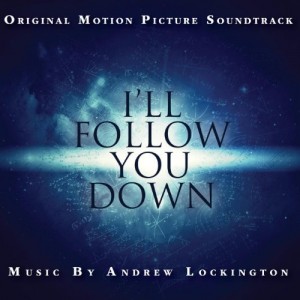
I’LL FOLLOW YOU DOWN soundtrack | ©2017 Intrada Records
AX: If THE SPACE BETWEEN US has a musical cousin, then it’s in your ethereal score for the time travel drama I’LL FOLLOW YOU DOWN.
LOCKINGTON: I really love sci-fi, so I was really excited when the filmmaker Richie Mehta told me the concept of the film and asked me to score it. It turned out to be even more interesting than I’d thought, because he made a film focusing on the morality and ethics around altering time. He didn’t focus on the technology. That allowed me to write a much more character driven score, a score that plays with the idea of time, backwards time and time out of order. After our initial conversations about all the cool new tech toys we could use to score the movie, we came full circle to a place that avoided all modern manipulation and used ancient and conventional instruments to score the story. There are some very complex keyboard passages in that score. My keyboarding skill improved greatly because of it.
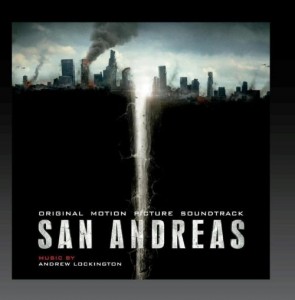
SAN ANDREAS soundtrack | ©2017 WaterTower Records
AX: What can we expect from the giant monster mash videogame adaptation RAMPAGE, your next movie with Brad, which also reteams you with The Rock?
LOCKINGTON: As with all Brad projects, we start talking about the music before the script is even finished. I’ve been researching this score and working with Brad to figure out an approach for the past six months and we’ve come up with a palette that I’m incredibly excited about. Music is so embedded in Brad’s plan for storytelling that often ideas we discuss actually influence some of the character and visual aspects of his films. Music is a parallel process for him. He was in Atlanta scouting locations last November and called me down to join him. Over the course of those few days we hatched our approach.
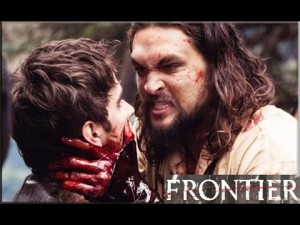
FRONTIER | ©2017 Netflix
AX: Can you talk about scoring Brad’s Netflix series FRONTIER, which just recently premiered? And what’s the challenge of making score for a “historical” score contemporarily vibrant?
LOCKINGTON: FRONTIER is a treacherous world to write for. The series takes place in the time of the fur trade – late 1700′s in the upper half of North America. The show is centered around Declan Harp (Jason Momoa), a Cree / Irish man who is seeking revenge for the death of his people. Around him are a cast of colorful characters who’ve been drawn to this dangerous world by greed and opportunity, as well as the people who’s land they all descended upon. It’s a power struggle between the British Hudson’s Bay Company, the Metis, the Cree, the French, the Americans and many independent factions vying for a piece of the trade.
I was very encouraged after speaking with Brad and the other producers. They all had an understanding how important the music was in their design the show. Early on I found a music consultant who had written a thesis on “Music of the fur trade”. This moment in history was fascinating because you had all of these different cultures and peoples coming together to trade and share goods. Gold, silver, weapons and fur weren’t the only currency – they also traded culture, rituals and music. As a result, music of the time incorporated elements of the other cultures around them – a perfect opportunity for a unique hybrid score.
While the majority of the instrumentation I use has historical justification, the producers gave me license to use these angles in a modern way. The score isn’t meant to console or encourage the people like the secular or sacred music of the time, but rather to narrate the true feelings and emotions experienced by our characters. There is fiddle, but it’s processed through a bit crusher, ring modulator and multiple filters. There are frame drums and ethnic winds, but they’re layered and manipulated into textures with delays. By combining these elements and manipulating them it gives the score it’s own sound, a set of rules and an identity right out of the gate. From there I wrote some orchestral themes that serve to act anthems for the missions of each group. The strings are the added element instead of the base element of the cues, which is backwards from how I’ve often worked in the past. It’s a very dark world to write for, but I love that we’re not trying to be too historical with the music and have instead lay out our own parameters for the sound of the show.
AX: The best movies like HIDDEN FIGURES and THE MARTIAN can make young viewers to reach for the stars. How do you hope that your music for a teen movie like THE SPACE BETWEEN US will help inspire its viewers in that fashion?
LOCKINGTON: I hope the film inspires it’s audience in the same way it inspired the team of us that worked on it. We all need to step back and take a look at our lives through fresh eyes, and with a fresh perspective sometimes. I think the film will resonate with all audiences and I know people will find it quite moving. I’m very proud to have contributed to that.
Take a trip with Andrew Lockington to “The Space Between Us” HERE on Sony Classical Records. Then travel back in time with Lockington as he says I’LL FOLLOW YOU DOWN on Intrada Records HERE, before rocking out with SAN ANDREAS on WaterTower Music HERE
Visit Andrew Lockington’s website HERE
AGREE? DISAGREE? LET YOUR VOICE BE HEARD – COMMENT BELOW
Follow us on Twitter at ASSIGNMENT X
Like us on Facebook at ASSIGNMENT X
Article Source: Assignment X
Article: Interview with THE SPACE BETWEEN US composer Andrew Lockington
Related Posts:




